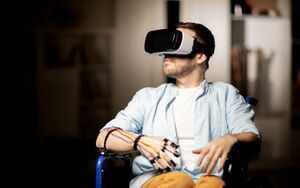VR simulations to help patients with neurological or musculoskeletal injuries: Difference between revisions
m (rearranged.) |
No edit summary |
||
| Line 1: | Line 1: | ||
{{DISPLAYTITLE:Virtual Reality Stimulation in Rehabilitation}} | |||
== Introduction == | == Introduction == | ||
[[File:VR-Wheelchair-838x525-1.jpeg|thumb]] | [[File:VR-Wheelchair-838x525-1.jpeg|thumb]] | ||
Revision as of 18:26, 22 April 2023
Introduction[edit | edit source]
Virtual reality (VR) technology has been used in recent years to develop simulations that can help patients with neurological or musculoskeletal injuries recover and regain their function. By immersing patients in virtual environments that mimic real-life scenarios, VR simulations can provide an engaging and interactive therapy experience that can improve patient engagement and compliance with therapy protocols. In this article, we will discuss the ways in which VR simulations can be used to help patients with neurological or musculoskeletal injuries.
Neurological Injuries[edit | edit source]
VR simulations can be used to help patients with neurological injuries such as stroke, traumatic brain injury (TBI), or spinal cord injury (SCI). Some examples of how VR simulations can be used in neurological rehabilitation include:
Balance training:[edit | edit source]
VR simulations can be used to provide balance training exercises that mimic real-life scenarios such as walking on uneven surfaces or stepping over obstacles.
Upper limb rehabilitation:[edit | edit source]
VR simulations can be used to provide upper limb rehabilitation exercises that mimic real-life scenarios such as reaching for objects or lifting weights.[1]
Cognitive rehabilitation:[edit | edit source]
VR simulations can be used to provide cognitive rehabilitation exercises such as memory and attention training.
Studies have shown that VR-based therapy can improve functional outcomes, motor performance, and quality of life in patients with neurological injuries. For example, a systematic review and meta-analysis of randomized controlled trials found that VR-based therapy was effective in improving upper limb motor function and reducing spasticity in patients with stroke (Laver et al., 2017).
Musculoskeletal Injuries[edit | edit source]
VR simulations can also be used to help patients with musculoskeletal injuries such as joint injuries, fractures, or soft tissue injuries. Some examples of how VR simulations can be used in musculoskeletal rehabilitation include:
Pain management:[edit | edit source]
VR simulations can be used to distract patients from pain during rehabilitation exercises, reducing the need for pain medication.[2]
Exercise therapy:[edit | edit source]
VR simulations can be used to provide exercise therapy that is more engaging and interactive than traditional methods, such as using a stationary bike or treadmill.
Studies have shown that VR-based therapy can improve pain, function, and quality of life in patients with musculoskeletal injuries. For example, a randomized controlled trial found that VR-based exercise therapy was effective in reducing pain and improving function in patients with knee osteoarthritis (Kuntze et al., 2020).
Conclusion[edit | edit source]
Virtual reality simulations represent a promising new tool in the rehabilitation of patients with neurological or musculoskeletal injuries. By providing an immersive and engaging therapy experience, VR simulations can improve patient engagement and compliance with therapy protocols, and ultimately improve patient outcomes. As research in this area continues to grow, it is likely that virtual reality simulations will become an increasingly important tool in the rehabilitation of a range of conditions.[3]
References[edit | edit source]
- ↑ Laver, K. E., George, S., Thomas, S., Deutsch, J. E., & Crotty, M. (2017). Virtual reality for stroke rehabilitation. Cochrane Database of Systematic Reviews, (11).
- ↑ Kuntze, G., Gollhofer, A., & Hoos, O. (2020). Virtual reality-based training increases function and reduces pain in patients with knee osteoarthritis: a randomized, controlled clinical trial. Journal of Clinical Medicine, 9(2), 363.
- ↑ Tariq, U., Rana, P. N., & Michalak, E. E. (2021). Virtual reality in the management of musculoskeletal pain: A narrative review. Journal of Back and Musculoskeletal Rehabilitation, 34(2), 163-173.







